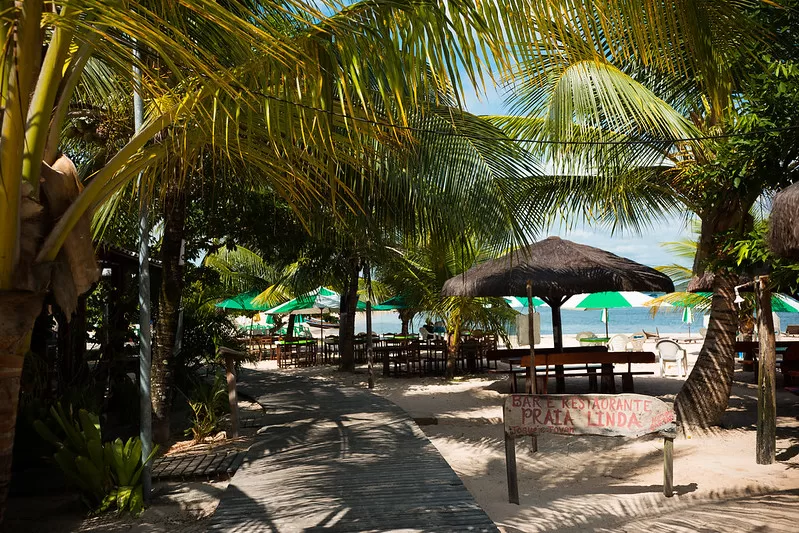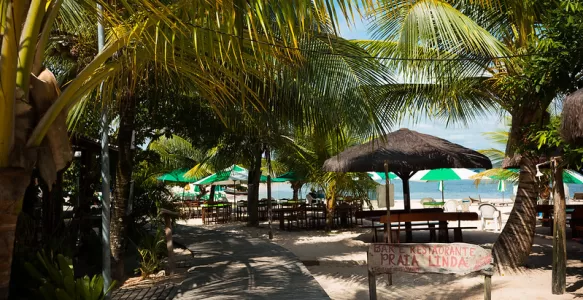Morro de São Paulo, one of Bahia’s most charming and popular tourist destinations, is renowned for its idyllic beaches, crystal-clear waters, and a vibrant atmosphere that seamlessly blends tranquility with lively energy. Beyond its natural beauty, the local gastronomy stands out as one of the region’s main attractions, enriching visitors’ experiences on this enchanting island. The culinary scene in Morro de São Paulo reflects a fusion of cultural influences, fresh ingredients, and longstanding traditions, culminating in a true celebration of flavors.

The Culinary Diversity of Morro de São Paulo
The gastronomy of Morro de São Paulo is characterized by a wide array of dishes catering to diverse tastes and preferences. From traditional seafood options to regional specialties of Bahia, the offerings are extensive and varied. This diversity results from the region’s history of immigration, intercultural contact, and the use of local ingredients, which ensure freshness and authenticity in every dish.
Restaurants and Their Specialties
Among the most renowned establishments, several stand out for providing a unique culinary experience, including Bella Vida Restaurant, Sabor da Terra, Buda Beach, Sambass Café, Capoeira Restaurant, El Sitio, Faixa de Preços, and others. Each offers distinct characteristics, yet all contribute to the richness of the local culinary landscape.
Bella Vida Restaurant
Bella Vida is celebrated for serving Bahian dishes with a focus on seafood, reflecting the maritime traditions of the region. Its dishes are prepared with fresh ingredients, ensuring high quality and flavor. The relaxed atmosphere makes it an ideal choice for those seeking a good meal in a laid-back setting.
Sabor da Terra
Another highlight is Sabor da Terra, which offers a diverse menu including meats, pasta, regional dishes, and seafood. Its location within Morro de São Paulo village provides a privileged view, making the dining experience even more special. The combination of traditional flavors and a welcoming ambiance makes this restaurant a popular choice among tourists and locals alike.
Buda Beach
Famous for its varied menu, Buda Beach appeals to different palates. Its concept is to provide a pleasant dining experience by the sea, with dishes ranging from seafood to international cuisine. It is considered one of the trendiest spots in the region, attracting visitors seeking quality and a relaxed environment.
Sambass Café
Sambass Café stands out for its delicious pasta, seafood, and international cuisine options. Its indoor and outdoor spaces offer a comfortable experience, blending modernity with coziness. The goal is to serve a culinary experience that appeals to both traditional food lovers and those seeking new flavors.
Capoeira Restaurant
Capoeira Restaurant is known for its diverse menu, especially sushi and Asian-inspired dishes. Located at Segunda Praia, with indoor seating and outdoor tables, it offers a comprehensive experience with a fusion of flavors that satisfy various tastes. The concept is to combine Asian flavors with local ingredients, creating a unique culinary fusion.
Bahian Regional Cuisine
Morro de São Paulo’s gastronomy also features traditional Bahian dishes that embody the region’s culture and history. Among these, the iconic acarajé, moqueca, vatapá, sarapatel, and other traditional recipes are integral to Bahia’s culinary heritage.
Acarajé
Acarajé is a Bahian culinary icon, made from black-eyed peas, fried in dendê oil, and filled with dried shrimp, vatapá, caruru, or other ingredients. Its preparation requires skill and tradition, making it one of the most appreciated delicacies by both tourists and locals.
Moqueca
Moqueca is a fish or seafood stew cooked with dendê oil, coconut milk, onions, tomatoes, peppers, cilantro, and other seasonings. Its origins trace back to indigenous and African traditions, reflecting Bahia’s cultural diversity. Morro de São Paulo’s moqueca is renowned for its bold flavor and irresistible aroma.
Vatapá
Vatapá is a creamy mixture of bread, coconut milk, shrimp, cashew nuts, dendê oil, and spices. It can be served as a side dish or main course, typically accompanied by white rice or acarajé. Its distinctive texture and flavor make it a favorite in local cuisine.
Sarapatel
Sarapatel is a Portuguese-origin dish prepared with pork offal, seasoned with spices, and cooked until tender. Despite its elaborate preparation, it is highly valued by those seeking intense and traditional flavors.
Seafood Dishes
Thanks to its coastal location, Morro de São Paulo offers an abundance of fresh seafood. Fish, shrimp, squid, octopus, and other marine ingredients are used in various preparations, from grilled to stews and moquecas.
Shrimp
Shrimp is one of the most utilized ingredients in local cuisine, featured in dishes such as shrimp in pumpkin, garlic shrimp, and the famous fried shrimp. Its versatility allows for combinations that appeal to different preferences.
Fish
Fish varieties like snapper, grouper, and others are prepared in multiple ways, including grilled, baked, or stewed. They are often served with special sauces, coconut rice, or dendê farofa, enhancing the flavors of the sea.
The Role of Gastronomy in the Local Economy
Morro de São Paulo’s culinary scene is not only about flavor but also a vital driver of the local economy. Restaurants, bars, and kiosks generate employment and income for the community. Additionally, emphasizing local ingredients and preserving traditional recipes help maintain the region’s cultural identity.
Culinary Tourism
Culinary tourism is a growing trend, and Morro de São Paulo excels in this area. Visitors seek not only idyllic beaches but also authentic culinary experiences. Participating in cooking classes, visiting food markets, and tasting regional dishes are activities that enrich their trip and promote local culture.
Sustainability and Use of Local Ingredients
Valuing local ingredients is essential for sustainable gastronomy in the region. Fresh seafood, dendê oil, cashew nuts, coconut, and regional spices ensure authentic and sustainable dishes. This practice also helps preserve the environment and local traditions.
The culinary scene in Morro de São Paulo is a true celebration of flavors, traditions, and cultures. Its dishes reflect the region’s history, marked by indigenous, African, and Portuguese influences, alongside the use of fresh ingredients from land and sea. The variety of restaurants and kiosks offers options for all tastes, making gastronomy an integral part of the visitor experience.
Whether savoring a fragrant moqueca, a crispy acarajé, a seafood platter, or simply enjoying local cuisine by the sea, Morro de São Paulo’s culinary offerings provide a sensory journey that enhances the natural beauty of this destination. Food here is not just sustenance but a cultural expression that connects past and present, tradition and innovation, making Morro de São Paulo a true paradise for food lovers.


